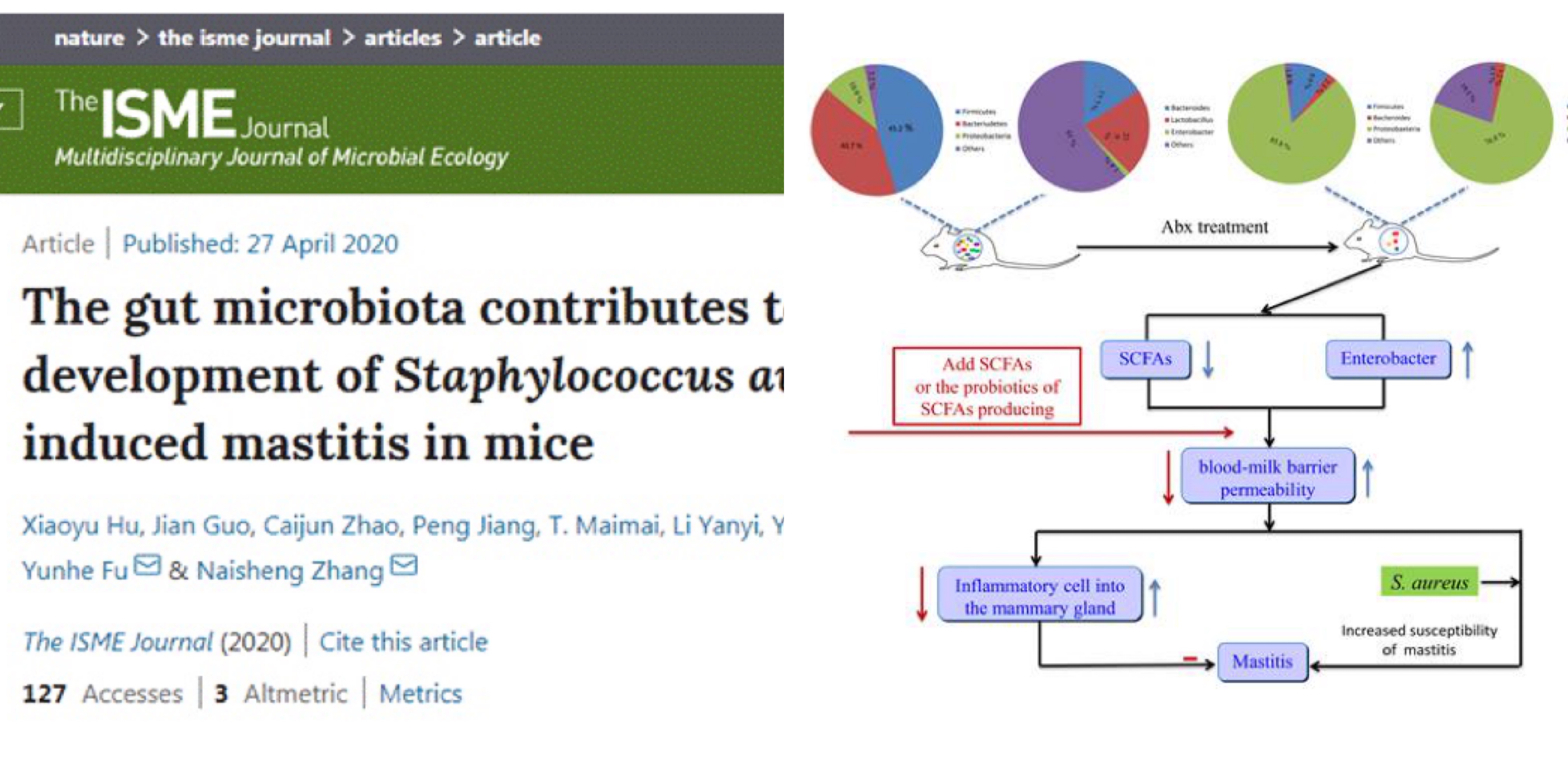Research results of Zhang Naisheng's team
Professor Zhang Naisheng’s team,College of Veterinary Medicine of Jilin University published an article "The gut microbiota contributes to the development of Staphylococcus aureus-induced mastitis in mice" in the Top Journal of Microbial Ecology (ISME journal). The influence of tract flora on mastitis and its associated mechanism.
Mastitis is not only the most important disease that endangers the dairy farming industry, but also causes public health safety risks such as drug and harmful substance residues, and the production of drug-resistant bacteria. The traditional concept believes that mastitis is a local inflammatory reaction caused by bacteria and other pathogenic microorganisms infecting the breast. However, clinically, the milk of some cows with mastitis only shows an increase in the number of somatic cells, but no pathogenic bacteria can be isolated; in addition, cow mastitis is often secondary or accompanied by foregastric relaxation and subacute rumen acidosis (SARA) And other digestive disorders; moreover, the local treatment effect for breast is limited, and there is no ideal prevention and control vaccine. Therefore, the author speculates that the occurrence of mastitis is not only related to the infection of external pathogenic microorganisms, but also endogenous pathogenic pathways.
The intestinal microflora is a large number of microbial communities with a wide variety of fixed values in the intestine. With the theories of "gut-lung axis", "gut-liver axis", "gut-brain axis", and "gut-kidney axis", the intestinal flora is not only essential for intestinal health, but also Intestinal bacteria and their metabolites migrate endogenously to remote organs outside the intestine such as the lungs, liver, brain, and kidneys, and cause related diseases. The thesis carried out experimental research on whether the intestinal flora disorder will affect the occurrence of mastitis, and whether the body also has problems such as "intestinal-mammary axis".
First of all, using broad-spectrum antibiotics to disrupt the intestinal flora and detect the relationship between the intestinal flora disorder and mastitis. The results show that the intestinal flora disorder can lead to an increase in the permeability of the blood-breast barrier, an increase in inflammatory cells that migrate across the blood-breast barrier to the breast, and induce breast inflammation (endogenous mastitis). When there is infection with pathogenic bacteria such as Staphylococcus aureus, the mammary gland inflammation of mice with intestinal flora disorder is more obvious, and transplantation of healthy mouse feces to mice with intestinal flora disorder significantly alleviates the mammary gland inflammation, indicating that the intestinal flora disorder Can exacerbate the severity of mastitis.
Further research found that antibiotic treatment resulted in a significant decrease in the content of short-chain fatty acid (SCFAs) producing bacteria and SCFAs in the intestines. Supplementing mice with SCFAs significantly alleviated the increase in the permeability of the blood-breast barrier and the inflammatory response of the breast induced by Staphylococcus aureus; moreover, Oral administration of live probiotics (butyric acid-producing bacteria) significantly increased the SCFAs content in the blood and mammary tissues of mice, and at the same time the blood-breast barrier destruction and mammary inflammation induced by Staphylococcus aureus were alleviated. These results indicate that SCFAs, which are metabolites of intestinal flora, may migrate from the intestine to the mammary glands and exert their effects on maintaining the integrity of the blood-breast barrier and anti-inflammatory. Based on this speculation, there is a close relationship between the intestinal flora and mastitis, suggesting that the body may have an "intestine-mammary axis", and the migration of intestinal flora and/or its metabolites may be related to each other. One of the most important ways to achieve this, its specific molecular biological basis still needs further research.
The research also reminds us that the various tissues and organs of the body are an interconnected whole. The prevention and treatment of local organ diseases (such as mastitis) should not only focus on the part (such as the breast), but also consider the whole, especially the maintenance of the intestine (rumen). The balance of the flora may be an important factor in the prevention and treatment of mastitis and other organ diseases. This not only provides new theoretical guidance and experimental basis for clinical prevention and treatment of dairy cow mastitis, but also has important reference significance for the prevention and treatment of other animal systemic, metabolic and infectious diseases.
Dr. Hu Xiaoyu from the College of Veterinary Medicine of Jilin University is the first author of the article, and Professor Zhang Naisheng and Professor Fu Yunhe are the corresponding authors of this article. This research was supported by the National Natural Science Foundation of China (31772812, 31972749,).
Original link: https://www.nature.com/articles/s41396-020-0651-1
